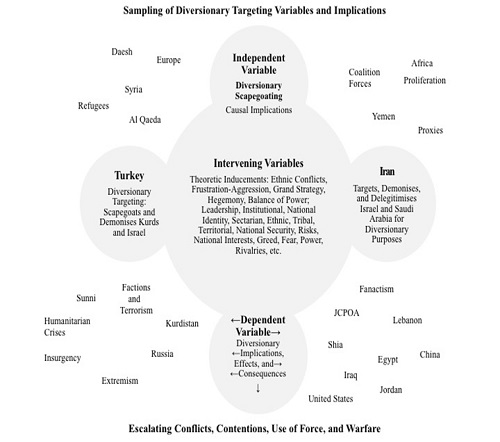Turkey & Iran Case Studies: An Introductory Summary to Diversionary Scapegoating
Allyson Christy
Introduction
Diversionary war theory generally denotes attention to troubled leadership that may juxtapose domestic quandaries with instigation or enjoining forces to external conflicts and crises. Often territorial clashes typify favourable, and therefore rallying conditions for intervention. Further attention to diversionary exploits highlights purposeful tactics subjective to scapegoating and demonising a target or targets, which may erratically accelerate prevailing peripheral contentions. Commencing with present and descriptive data using two concurrent case studies, Turkey and Iran and relevance to regional-wide pandemonium affecting the Middle East, similarly supports two coincident paradigms of extended targeting diversion and warfare. Developing qualitative evidences alongside inductive and intuitive analyses also combine with theorising international relations found to be consistent with broadening discord, and that may be inclusive to past and proximate geo-political conditions. Predictive outcomes of expanded havoc respective to both Turkey’s and Iran’s use of target scapegoating and demonising diversion, likewise support empirical inferences to diversionary warfare theory. Both case studies involve comparable hegemonic objectives that further upset ethnic and sectarian imbalances, and have hindered coalition efforts at countering violent extremism and insurgency by continuing to manipulate the immediate and outlying regional disparities with replicated conflict and warfare.
Intervention and Theoretic Contexts
Historical inducements to conflict are proportionate to international relations and any theoretical assessments that may compare to factors of ethnic conflict and frustration-aggression. Employing a diligent exploration of patterns and consistencies with ethnographic sensitivities and resultant divisive factors reaffirms targeting causation to regional dissonance. Supplementing with a conclusive phenomenological explanation may also induce credibility for identifying and clarifying variables of intensifying interventions, and will necessitate research that integrates historically based sensitivities with analysis. Preceding studies of diversionary war theory often include conventional inferences that originate with territorial contexts (Tir 2010, 413). Nevertheless, foreign targets may also be routinely correlated with domestic vulnerabilities or contentions involving state entities and further manipulated against such backdrops¾purposefully highlighted and targeted as intense or threatening. Moreover, researcher, Sung Chul Jung, PhD, conducts a framework for also identifying states that might “attract diversionary actions by domestically troubled states” (2014, 566). Attention to leadership that is undermined, deemed unqualified, or weakened is integrally linked to political disrespect and unpopularity. Instituting systematic diversionary actions may also associate to “personal political survival” and thereby be used in seeking an impression of “competence” and ultimately maintaining power (Jung 2014, 566).
Diversionary strategies that employ scapegoating and demonising tactics may draw comparisons with domestic troubles and theoretic scholarship that highlights the manipulative and yet powerful effects of “rallying around the flag” (Tir 2010, 413). Such findings are largely attributed to regimes or entities that employ diversionary tactics, and include both, democratic and authoritarian traditions. Connecting governmental typologies and institutional characteristics as determinate factors may similarly link meddlesome gambits with initiating an actual “diversionary use of force” (Pickering and Kisangani 2005, 24). To such matters, socio-political and economic factors motivate, compel, and consequently implicate domestic stressors. Proliferating contentious frameworks of grand strategy promulgation, for example, may consequently underscore a far-reaching outcome. Such institutional behaviours are synchronously convergent and particularly subsequent to the 9/11 attacks (Kanat 2014, 17). By way of state fragmentations, violent extremism, terrorism, and escalated proxy distractions increasingly have dominated the rivalling landscapes of the Greater Middle East, and thereby correspondingly link Turkey and Iran with grandiloquence characteristics.

An Introductory Framework to Variable Indications
References
Jung, Sung Chul. 2014. “Foreign Targets and Diversionary Conflict.” International Studies Quarterly 58, no. 3:566-578. (Accessed 10 August 2015). Academic Search Premier, EBSCOhost.
Kanat, Kilic. 2014. “Diversionary Foreign Policy in Authoritarian States: The Use of Multiple Diversionary Strategies by Saddam Hussein during the Gulf War.” Journal of Strategic Security 7, no. 1: 16-32. (Accessed 10 August 2015). http://search.proquest.com/docview/1618201353?accountid=8289
Pickering, Jeffrey, and Emizet F. Kisangani. 2005. “Democracy and Diversionary Military Intervention: Reassessing Regime Type and the Diversionary Hypothesis.” International Studies Quarterly 49, no. 1: 23-43. March. (Accessed 7 October 2016). http://www.jstor.org/stable/3693623.
Tir, Jaroslav. 2010. “Territorial Diversion: Diversionary Theory of War and Territorial Conflict.” Journal of Politics 72, no. 2: 413-425. April. (Accessed 7 October 2016). http://www.jstor.org/stable/10.1017/s0022381609990879
